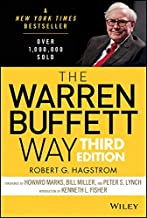Book Summary of The Warren Buffett Way
by Robert G. Hagstrom

What is this book "The Warren Buffett Way" about?
"The Warren Buffett Way" by Robert G. Hagstrom is an in-depth exploration of the investment strategies and principles of Warren Buffett, one of the most successful investors in history. The book delves into Buffett's investment philosophy, focusing on how he selects stocks, manages portfolios, and approaches long-term value investing. It provides case studies of some of Buffett's most significant investments and explains the underlying tenets that guide his decisions.
Who should read the book "The Warren Buffett Way"?
This book is ideal for investors, financial professionals, business students, and anyone interested in learning more about Warren Buffett's approach to investing. It is also suitable for readers who want to understand value investing and the principles of long-term investment success. Beginners in investing can gain foundational knowledge, while seasoned investors can refine their strategies by learning from Buffett's methods.
10 Big Ideas from the Book "The Warren Buffett Way"
- Value Investing: Buffett believes in purchasing stocks that are undervalued in the market but have strong fundamentals.
- Long-Term Focus: He emphasizes the importance of holding investments for the long term, often decades, to realize their full value.
- Buying Businesses, Not Stocks: Buffett sees stock purchases as buying a piece of a business, which leads to a more careful selection process.
- Margin of Safety: Investing with a margin of safety means buying stocks at a price lower than their intrinsic value, reducing risk.
- Circle of Competence: Investors should stick to industries and businesses they understand well.
- Management Quality: Buffett places a high value on the quality of management in the companies he invests in, favoring those with integrity and talent.
- Economic Moats: Buffett looks for businesses with a strong competitive advantage or "moat" that protects them from competitors.
- Focus Investing: Rather than diversifying widely, Buffett believes in concentrating on a few well-researched investments.
- Patience and Discipline: Successful investing requires patience, waiting for the right opportunities, and the discipline to stick to a well-thought-out plan.
- Rationality Over Emotion: Buffett stresses the importance of making investment decisions based on logic and analysis rather than emotions.
Summary of "The Warren Buffett Way"
"The Warren Buffett Way" by Robert G. Hagstrom is a detailed exploration of the investment strategies and principles of Warren Buffett, one of the most successful investors of all time. The book provides readers with insights into how Buffett selects stocks, manages portfolios, and consistently achieves superior investment returns by focusing on value investing and long-term growth.
1. Warren Buffett's Investment Philosophy
- Value Investing: Buffett’s strategy revolves around buying stocks that are undervalued but have strong fundamentals. He looks for companies with intrinsic value higher than their current market price.
- Long-Term Perspective: Buffett is known for holding investments for long periods, often decades. His philosophy is that time is a friend of the wonderful business.
- Buying Businesses, Not Stocks: Buffett sees stock investments as owning a piece of a business. This mindset ensures a more careful and thorough analysis before investing.
- Margin of Safety: This concept, originating from Benjamin Graham, means buying securities at a significant discount to their intrinsic value to minimize risk.
2. The Twelve Immutable Tenets
Business Tenets
-
Is the business simple and understandable?
- Buffett prefers to invest in businesses that are straightforward and easy to understand. He avoids companies involved in overly complex industries or those with unclear business models. Simplicity ensures that he can fully grasp how the company operates and generates revenue.
-
Does the business have a consistent operating history?
- A track record of consistent performance over several years is crucial. Buffett looks for businesses with stable and predictable earnings, as these indicate reliability and reduce investment risk.
-
Does the business have favorable long-term prospects?
- Buffett invests in businesses that have the potential for sustainable growth over the long term. He seeks out companies with strong competitive advantages (or "economic moats") that protect them from competitors and allow them to maintain profitability.
Management Tenets
-
Is management rational?
- Rational management is key to making sound business decisions. Buffett values leaders who allocate capital effectively, reinvest profits wisely, and avoid unnecessary risks. Management should prioritize long-term growth over short-term gains.
-
Is management candid with its shareholders?
- Transparency and honesty are vital qualities in a company’s management. Buffett favors leaders who are open about the company's performance, admit mistakes, and provide clear, straightforward communication with shareholders.
-
Does management resist the institutional imperative?
- The institutional imperative refers to the tendency of companies to follow industry trends and practices without question. Buffett prefers management teams that think independently and make decisions based on what is best for their company, rather than succumbing to external pressures or fads.
Financial Tenets
-
Focus on return on equity (ROE) rather than earnings per share.
- ROE is a measure of how efficiently a company uses shareholders' equity to generate profits. Buffett emphasizes ROE over earnings per share (EPS) because it better reflects the company’s profitability and how well management is utilizing resources.
-
Calculate "owner earnings" to get a true picture of the company's profitability.
- "Owner earnings" is Buffett’s preferred method for assessing a company’s true profitability. It is calculated as net income plus depreciation, amortization, and other non-cash charges, minus capital expenditures and any additional working capital required to maintain the business. This metric provides a more accurate reflection of cash flow available to shareholders.
-
Look for companies with high profit margins.
- High profit margins indicate a company's ability to control costs and generate significant profits from its revenues. Buffett looks for businesses that consistently achieve above-average profit margins, as this suggests a competitive advantage and efficient operations.
Market Tenets
-
What is the value of the business?
- Determining the intrinsic value of a business is crucial before making an investment. Buffett assesses the future cash flows that the company is expected to generate and discounts them back to their present value. He compares this intrinsic value with the current market price to identify undervalued opportunities.
-
Can the business be purchased at a significant discount to its value?
- Buffett follows the principle of buying a "dollar for fifty cents." He seeks to purchase stocks at prices significantly below their intrinsic value, providing a margin of safety that reduces risk and increases potential returns.
-
Understand the market dynamics and investor behavior.
- Buffett recognizes that markets are not always rational and can be influenced by investor emotions such as fear and greed. He capitalizes on these market inefficiencies by buying when others are selling in panic and selling when others are buying in euphoria. Understanding market psychology is key to making informed investment decisions.
3. Key Financial Ratios
- Return on Equity (ROE): Buffett prefers companies with an ROE consistently above 15%. This ratio measures how efficiently a company uses shareholders' equity to generate profits.
- Debt-to-Equity Ratio: Buffett looks for companies with low debt, often a ratio below 0.5, indicating financial stability and less risk.
- Profit Margin: High profit margins are essential, as they indicate a company’s ability to generate profits from its revenue. Buffett favors companies with profit margins significantly higher than the industry average.
- Price-to-Earnings (P/E) Ratio: While Buffett doesn’t focus solely on P/E, he considers it when evaluating whether a stock is undervalued. He prefers companies with a P/E ratio lower than the industry average if the business has solid growth prospects.
- Price-to-Book (P/B) Ratio: Buffett often looks for a P/B ratio below 1.0, which can indicate that a stock is undervalued relative to the company's book value.
4. Case Studies
- The book provides nine case studies of Buffett’s major investments, including companies like Coca-Cola, American Express, and GEICO. These cases illustrate how Buffett applied his investment tenets to real-world scenarios, achieving substantial returns.
5. Portfolio Management
- Focus Investing: Buffett's strategy involves concentrating on a few high-quality stocks rather than diversifying widely. This focus allows for more in-depth analysis and understanding of each investment.
- Patience and Discipline: The book emphasizes the importance of patience, waiting for the right investment opportunities, and the discipline to stick with a well-thought-out investment plan.
6. Behavioral Finance
- Buffett’s approach to investing also involves understanding the psychological aspects of the market. He emphasizes the importance of being rational and not swayed by market emotions, such as fear or greed.
Key Ratios to Remember:
- Return on Equity (ROE): Target consistently above 15%.
- Debt-to-Equity Ratio: Preferably below 0.5.
- Profit Margin: Significantly higher than industry average.
- Price-to-Earnings (P/E) Ratio: Considered in context, preferably lower than industry average for strong growth companies.
- Price-to-Book (P/B) Ratio: Often below 1.0, indicating potential undervaluation.
Conclusion
"The Warren Buffett Way" provides a comprehensive guide to understanding and applying the investment principles of Warren Buffett. By focusing on value, quality management, financial health, and long-term growth, the book outlines a path that can lead to successful investing, though it requires discipline, patience, and a commitment to understanding the businesses behind the stocks.
Which other books are used as reference?
The book references several key works that have influenced Warren Buffett's investment philosophy, including:
- "Security Analysis" by Benjamin Graham and David Dodd: A foundational text on value investing that has significantly influenced Buffett.
- "The Intelligent Investor" by Benjamin Graham: Another seminal work by Graham, offering essential principles of value investing that Buffett has often cited.
- "Common Stocks and Uncommon Profits" by Philip Fisher: This book introduced Buffett to the concept of investing in quality companies with strong growth potential.
- Berkshire Hathaway's Annual Reports: These reports, written by Buffett, provide insight into his investment decisions and strategies over the years.
Browse Summaries of Top Investing books!
You may also like the below Video Courses



